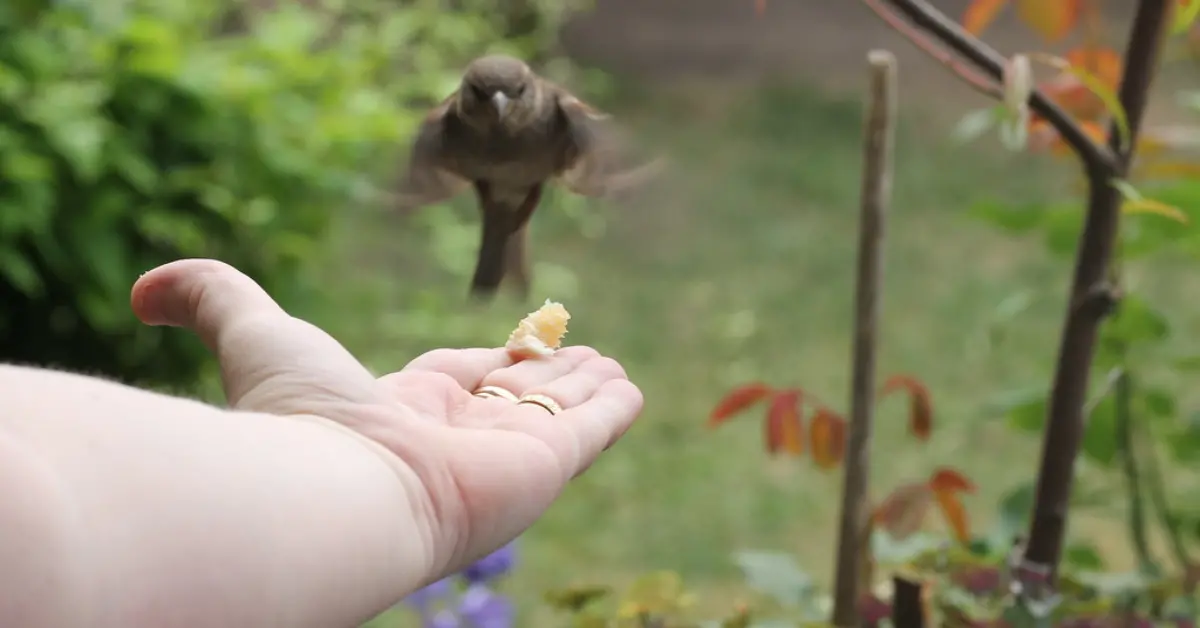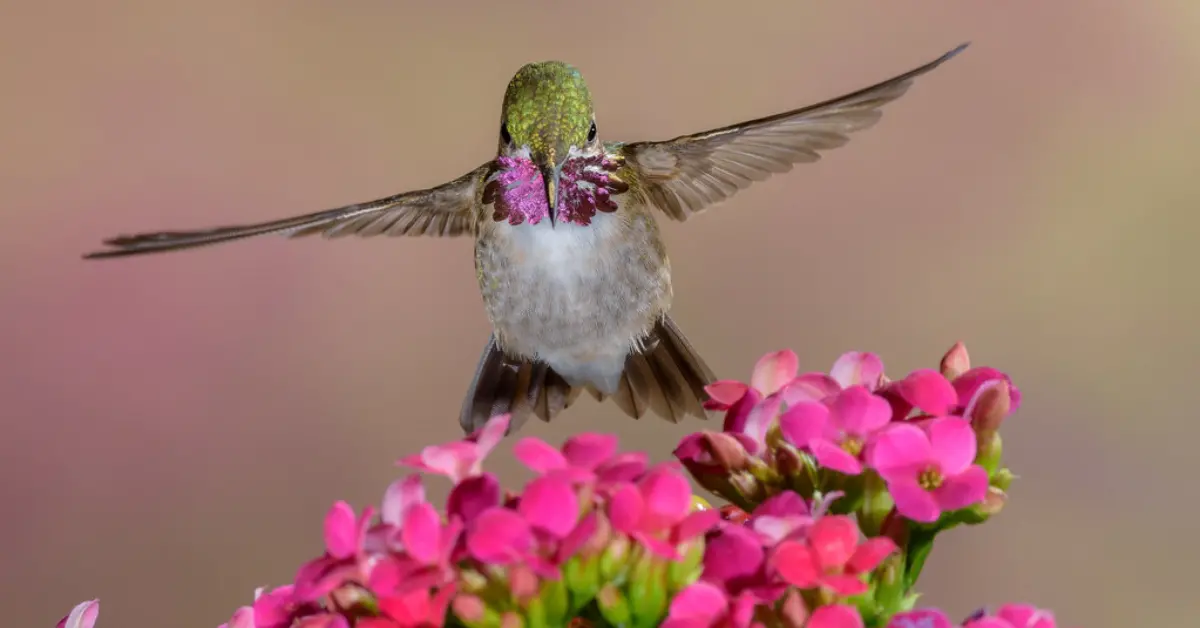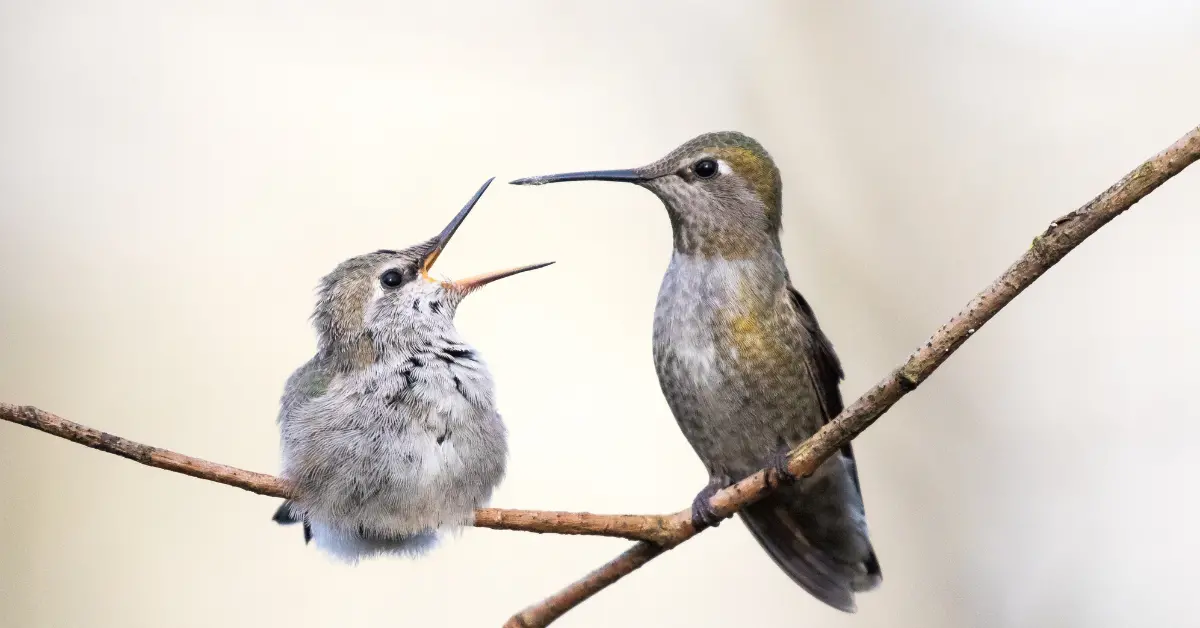There are at least seventy-four different gray-colored bird species in North America. The list of gray birds in North America ranges from tiny acrobatic flycatchers to large and ominous raptors. In this article, we cover everything from why gray birds are gray to how to identify 20 common gray birds!
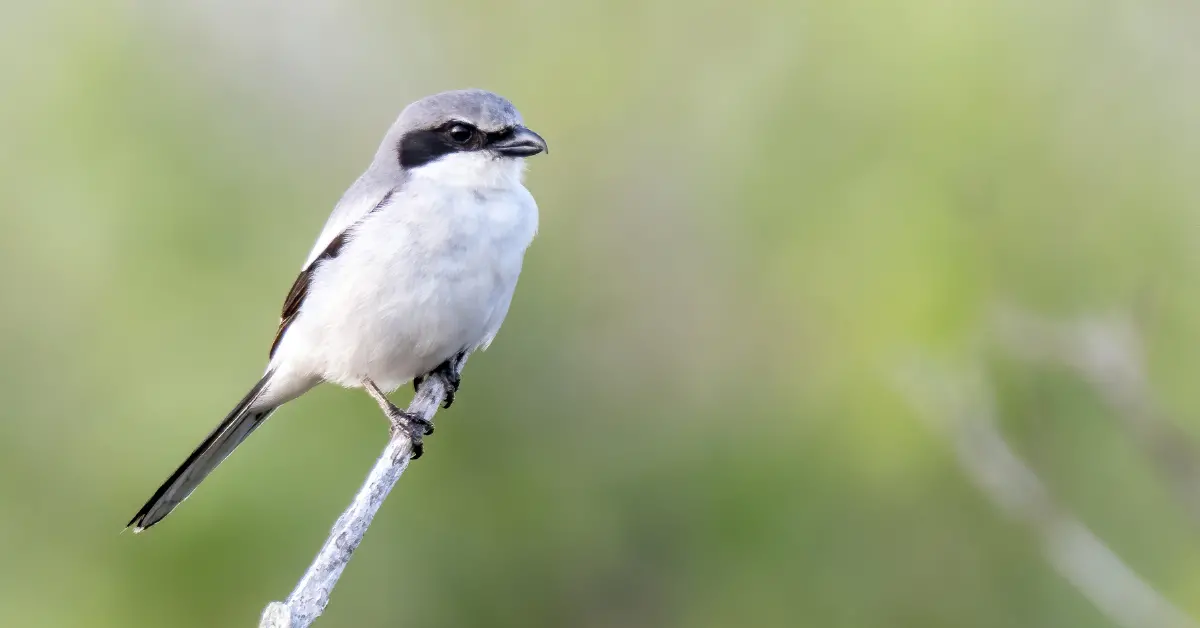
Why Are Gray Birds Gray?
Coloration in birds is influenced by both pigmentation and feather structure. Some gray birds are truly gray, while others only appear to be, depending on whether the gray is a result of pigmentation or feather structure. True gray comes from the pigment melanin which creates black, brown, and gray feathers. Gray birds typically have melanin present, but in a low concentration. This creates genuinely gray feathers.
Gray coloration, due to the feather’s microstructure, on the other hand, is not entirely genuine. Feather structure influences how light is reflected and scattered. A specific microstructure creates feathers that appear to be gray. This occurs when all wavelengths of light are scattered equally, resulting in a non-colorful appearance.
Advantages of Gray Coloration in Birds
There are advantages to being a gray bird. For starters, it is great camouflage. This is especially true in contemporary urban areas, characterized by concrete, asphalt, and towering buildings. Gray coloration also helps birds blend in with the forest’s bark, branches, and shadows. This coloration even makes birds less visible when flying in overcast skies. It is also genetically simpler and less energy-intensive to produce gray than bright coloration.
Behavior of Gray Birds
Gray bird species tend to share many similar behaviors. This is mainly due to sharing similar ecological roles and habitats, as those who have evolved to be the same color likely live in a similar landscape with similar predators, prey, advantages, and disadvantages. Let’s take a look at a few.
Many birds use bright coloration to attract mates. Gray birds, not having the fancy plumage of, say, a painted bunting, must do things a little differently. Gray birds rely heavily on songs and territorial displays, such as posturing and flight displays, during courtship. Additionally, species in which both males and females are gray typically share parenting duties once courtship is complete.
Gray birds are shy and have a tendency to seek cover. For this reason, many are ground-foraging birds. They are often forest-dwellers, a habitat that allows them to blend in with the leaf litter while foraging.
Gray birds are often ‘suburban-friendly’. This means they adapt well to human spaces as their plumage helps them blend into our built environments. Examples include Rock Pigeons, Mourning Doves, Mockingbirds, and Nuthatches.
20 Gray Birds in North America You Might See
Below are twenty common gray birds found in North America, along with their description, where to spot them, and how to attract them to your backyard!
Northern Mockingbird: Bold, Active Gray Birds
The Northern Mockingbird is a medium-sized, light gray bird with white wing patches and outer tail feathers. It is best known for its mimicry abilities. It copies dozens to hundreds of song variations, including other animal noises, such as birds and frogs, as well as human-made noises, like car alarms. This bird, unlike most gray birds, is bold and very active.
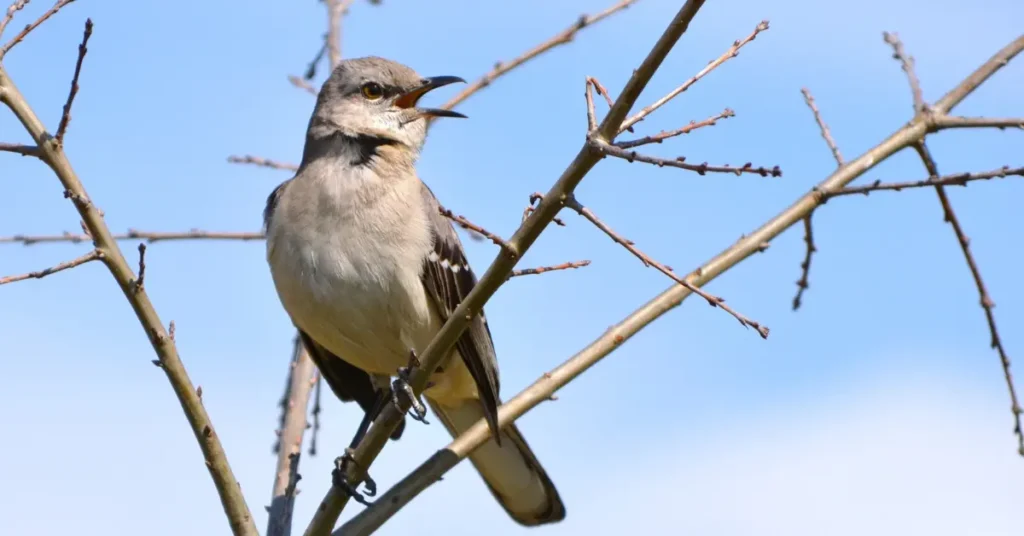
Northern Mockingbirds live in suburbs and cities. They enjoy parks, woodlands, and fields with scattered trees and shrubs. They live year-round across the continental U.S.
Gray Catbird: A Master of Mimicry
The Gray Catbird, named for its cat-like call, has a gray body, a black cap, and a rusty undertail. It is eight to nine inches in length. Like the Northern Mockingbird, these gray birds are also masters of mimicry. However, Gray Catbirds mastered stringing different sounds together into a single continuous song, and they rarely repeat phrases.

It enjoys sulking in dense shrubs and low branches. For this reason, Gray Catbirds live in dense shrubs, overgrown fields, and backyards with thick vegetation. This species is common throughout most of North America in spring and summer.
Mourning Dove: Most Common Gray Bird
Mourning Doves are gray-brown overall with black spots on the wings, a pale chest, and a white-tipped tail. They are medium-sized, slender, and graceful. It is known for its mournful cooing call, often mistaken for an owl. The common Mourning Dove also produces another sound- loud wing whistles on takeoff and landing.

Mourning Doves are widespread across North America. They live in backyards, parks, forests, cities, and suburbs and are one of the most common gray birds found in the U.S.
Dark-Eyed Junco: The Speedy Nest Builder
The coloration of this bird varies by region. Most commonly, Dark-Eyed Juncos have slate-gray upper bodies, white bellies, and a pink bill. Some have rusty flanks, especially in the eastern U.S. They are small birds, often only five to six inches in length. They enjoy residing in small groups and hopping around on the ground.

The Dark-Eyed Junco breeds in coniferous and mixed forests across Canada, Alaska, and the western U.S where they speedily build nests. In the fall and winter, it migrates to woodlands, backyards, parks, and open country with scattered trees.
Tufted Titmouse: Gray Birds with a Distinct Call
The Tufted Titmouse has gray upperparts, a white belly, and a rusty flank. It has a white face, a black forehead, and a distinctly gray crest. It is a small songbird, roughly six inches in length, known for its clear call, which sounds very similar to “peter-peter-peter”.

This gray bird species resides year-round in the eastern and southeastern U.S. The Tufted Titmouse prefers deciduous and mixed forests, wooded suburbs, and parks and gardens with large trees.
White-breasted Nuthatch: Acrobatic Gray Birds
The White-breasted Nuthatch is a gray-blue bird with a white face and underparts and a black cap. Males have a solid black crown, while females have a duller or grayish crown. They are five to six inches in length. These gray birds are known for climbing down trees headfirst as they forage for insects, and their nasal honking call, which sounds like “yank-yank-yank.”

This bird species lives year-round in most of the U.S., southern Canada, and parts of Mexico. They prefer mature deciduous forests, wooded suburbs and parks, and backyards with large oak and maple trees.
Canada Jay: Birds That Want to Be Friends
The Canada Jay, also known as the Gray Jay, Whiskey Jack, or Camp Robber, is a soft gray colored bird. It has a lighter face and a dark gray cap. They are medium-sized, around nine to eleven inches in length. With its intelligent and tame nature, it often approaches hikers and campers in a plea for shared food.

This bird inhabits boreal forests and high-elevation coniferous forests year-round. Canada Jays prefers spruce, fir, pine, and aspen forests in cool climates of the western U.S. and Canada.
Loggerhead Shrike: The Butcher Bird
The Loggerhead Shrike, also known as the ‘Butcher Bird’, has a pale, gray body, a black mask across the eyes, a white belly, black wings with white patches, and a black tail with white edges. It is about nine inches in length and has a hooked, raptor-like beak. Known for its hunting abilities, its prey consists of insects, small mammals, reptiles, and even small birds. It kills its prey by impaling it on thorns or barbed wire.

This bird inhabits open country with scattered shrubs, trees, fences, and utility wires, providing both cover and hunting grounds. It is widespread in the southern and central U.S. It used to be present in the northern U.S. and Canada, but populations have been declining.
Eastern Kingbird: Highly Territorial Birds
The Eastern Kingbird is a species of flycatcher. It is blackish gray with white underparts and a distinctive white tip on its tail. Their tiny red crown patch is visible during aggressive displays. They measure eight to nine inches. This is a highly territorial bird and even chases off hawks and crows many times its size. The Eastern Kingbird has a high-pitched, electric-sounding call: “tzee-tzee-tzee”.

They prefer areas with scattered trees or fences near water. Common habitats include orchards, field edges, and lake and river margins across Canada and the eastern and central U.S.
Blue-gray Gnatcatcher: Buzzy Gray Birds
The Blue-gray gnatcatcher is a small, hyperactive bird with a twitchy tail. It is a soft gray with white underparts and a long, narrow, black-and-white tail. During breeding, males develop a distinctive black eyebrow line above their eyes. They are four to five inches long and are lightweight. They have thin voices that project a high-pitched call. Their song is a buzzy sound.

These blue-gray birds reside in deciduous woodlands, forest edges, and thickets across the eastern, central, and southwestern U.S. They migrate to the southern U.S., Mexico, Central America, and the Caribbean in the winter.
Townsend’s Solitaire: Gray Birds with Beautiful Calls
This is a shy, altitude-dwelling bird of gray coloration with white outer tail feathers, a white eye ring, and subtle buff-gray wing patches. The Townsend’s Solitaire is a medium-sized bird and has a beautiful song called a whit. This is often sung during early spring and is described as ‘flutelike’. This solitary bird is noted for its ability to sit perfectly still for long periods while perched.
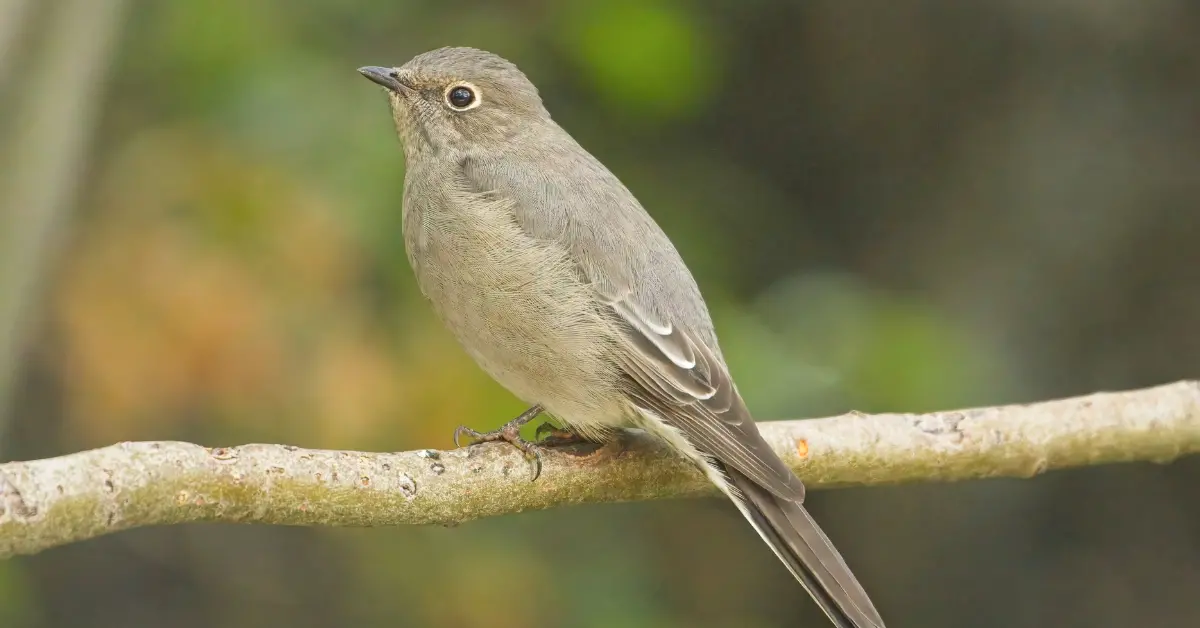
Townsend’s Solitaires live in mountain forests, coniferous or mixed woodlands, and rocky hillsides, cliff edges, and canyons. In particular, they enjoy juniper woodlands, drawn by the plentiful berry crops in winter. It is common for this bird to migrate to lower elevations during winter, such as towns, foothills, and arid areas with berry-rich vegetation.
Northern Shrike: Songbird-Sized Predator
The Northern Shrike is a songbird-sized predator. It has pale gray upperparts, light underparts with faint barring, black wings, and a black mask across the eyes. It has a hooked raptor-like bill. Like our friend the Loggerhead Shrike, it impales its prey on thorns or barbed wire.

It breeds in northern boreal forests of Alaska and Canada and winters in the continental U.S. in fields and forest edges. The Northern Shrike is found on the edges of suburban neighborhoods in winter.
California Towhee: Californian Ground-Dwelling Birds
The California Towhee is a dull brownish-grey bird with a touch of rufous around the face. It is approximately eight to nine inches in length and has a chunky appearance and enjoys hopping along the ground and foraging through leaf litter. Usually, this bird is found alone or in pairs. Its call is a simple and fast repeated trill that sounds like “chek-chek-chek”.
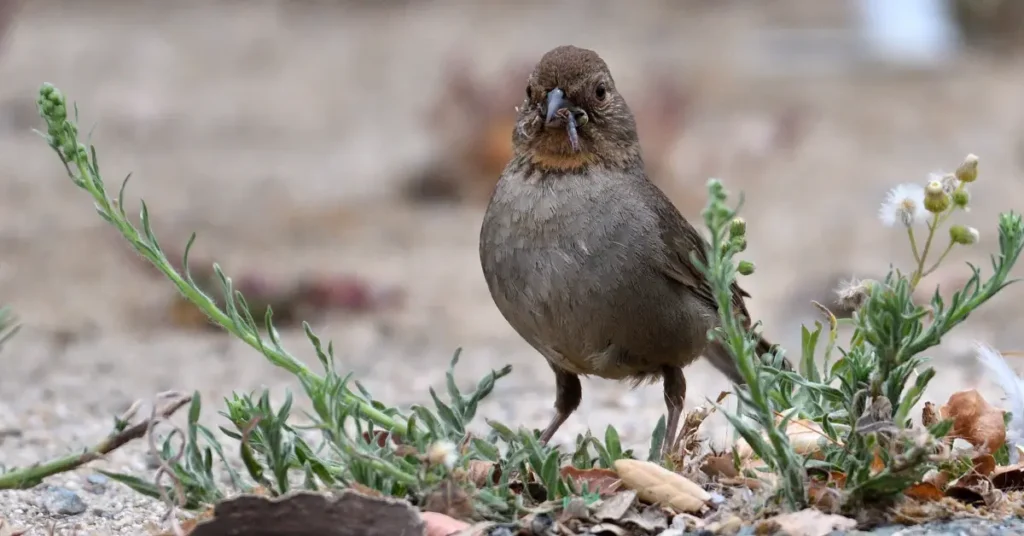
This ground-dwelling bird is native to California. Its preferred habitat is backyards, but it also resides in oak woodlands, gardens, and city parks, and coastal sage scrub. The California Towhee lives year-round in California and parts of southwestern Oregon.
Pinyon Jay: Birds of the Pinyon Pine Woodlands
The Pinyon Jay is named after its relationship with the pinyon pine woodlands. It is a sociable jay with gray uppers, blue underparts, and a grayish patch on the throat. Birds of this species are on the large side of medium. It is a noisy bird with a harsh, nasal call that emanates through the air.

Its habitat is typically pinyon-juniper woodlands in the intermountain region of the western U.S.
Cassin’s Kingbird: Gray Flycatchers
The Cassin’s Kingbird is a flycatcher of the continental west. It has a gray head and chest, a yellow belly, a white throat, and a dark tail with pale edges. This is a medium-sized and slender bird. The Cassin’s Kingbird has a sharp, loud call described as “chi-beer” or “kip-kip-kip”.

These gray birds inhabit woodlands, savannas, desert scrub, and suburban areas, characterized by a mix of tall trees and open spaces. This includes the southwestern U.S., California, and Mexico. It migrates to Central America in winter.
Great Crested Flycatcher: Gray Bird with Distinctive Call
The Great Crested Flycatcher is gray bird with a yellow belly and undertail. It is seven to nine inches long, with a loud and rolling call that is distinctive and often heard in the summer woods of eastern and central U.S.

This species prefers deciduous forests, mixed woodlands, forest edges, and suburban parks with mature trees.
Western Kingbird: Gray Birds with Piercing Calls
The Western Kingbird is a variation of the flycatcher. It has a grey head and chest, a bright yellow belly, and a white throat. It is medium length and has a sharp, piercing call. Western Kingbirds often perch on fence posts, power lines, or treetops from which they plunge to catch flying insects.

It enjoys open country (unlike most gray birds). It resides mostly in the western U.S., southern Canada, and parts of Mexico.
Rock Pigeon: Most Common City Pigeon
The Rock Pigeon is the most common city pigeon. It is gray with two black wing bars and has an iridescent green and purple neck. It is twelve to fourteen inches long and walks rather than hops. They are very social, ground-feeding birds.

Rock Pigeons have habitats globally and is found widely across North America in urban, suburban, and rural areas. In its ancestral habitat, it enjoys cliffs and rocky outcrops.
Eurasian Collared-Dove: Introduced Gray Birds
The Eurasian Collared-Dove is a pale gray dove with a slightly pinkish hue on its chest and a narrow black collar on the back of its neck. It is twelve to thirteen inches long and is often seen in pairs. It walks on the ground and perches on wires and rooftops.

The Eurasian Collard-Dove’s habitat ranges from suburban areas, small towns, parks, open woodlands, residential backyards, and barns, to open farmland near grain silos. It is native to Europe and Asia, but it is widely found in ranges across the U.S.
Band-Tailed Pigeon: Forest-Dwelling Pigeons
The Band-Tailed Pigeon is a shy, forest-dwelling pigeon native to the western U.S. It has a grayish-purple coloration and a green iridescence on the back of its neck. The Band-Tailed Pigeon has a yellow bill and legs and a white crescent at its nape. It is large, thirteen to sixteen inches in length.

It forages in flocks and feeds in trees, rather than on the ground.
Gray Birds Are Unique and Beautiful in their Own Way
There are nearly eighty species in North America alone, and each one ought to be appreciated. After learning about gray birds, head to our guide to the world’s most colorful birds to compare species!


